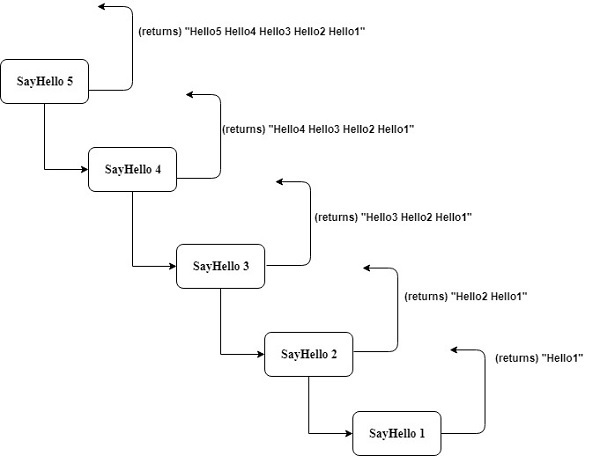
- ELM - Home
- ELM - Introduction
- ELM - Environment Setup
- ELM - Basic Syntax
- ELM - Data Types
- ELM - Variables
- ELM - Operators
- ELM - Decision Making
- ELM - Loop
- ELM - Functions
- ELM - String
- ELM - List
- ELM - Tuples
- ELM - Records
- ELM - Error Handling
- ELM - Architecture
- ELM - Package Manager
- ELM - Messages
- ELM - Commands
- ELM - Subscriptions
- ELM Useful Resources
- ELM - Quick Guide
- ELM - Useful Resources
- ELM - Discussion
Elm - Loop
Elm is a functional programming language. Elm uses the concept of recursion as an alternative to traditional looping constructs.
This chapter discusses the concept of recursion.
Recursion
Some computer programming languages allow a module or function to call itself. This technique is known as recursion.
Illustration
In this program, we will see how to use recursion to display hello five times.
Step 1 − Create a file Loop.elm
Create a module Loop and define a function sayHello. The function sayHello takes an integer value as input and returns a string value.
module Loop exposing(..) //function signature sayHello:Int ->String //function implementation sayHello n = case n of 1 -> "Hello:1 " _ -> "Hello:" ++ toString (n) ++ " " ++ sayHello(n-1)
The function sayHello checks if parameter passed is 1. If the parameter is 1, then function will return, otherwise it will create a string Hello and call the same function.
Step 2 − Invoke sayHello from REPL
Open the elm REPL from current project folder (location of Loop.elm file).
//import the module Loop > import Loop exposing(..) //invoke the sayHello function with parameter value as 5 > sayHello 5 "Hello:5 Hello:4 Hello:3 Hello:2 Hello:1 Hello:0 " : String >

Illustration
The following example prints the sum of n numbers using recursion.
> sumOfNos n =\ | if n==0 then 0 \ | else (n) + sumOfNos (n-1) <function> : number -> number1
In the elm REPL, we created a function sumOfNos that takes an input number and sums all numbers from 0 to that number.
For example, if we pass input as 5, it will sum up 1+2+3+4+5 which is 15.
> ssumOfNos 5 15 : number
The output of the program is shown above.